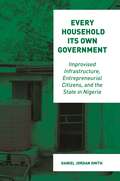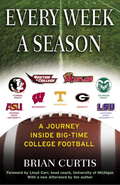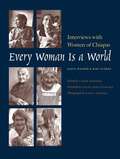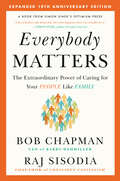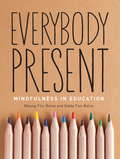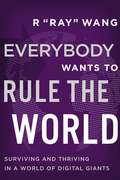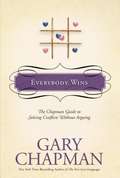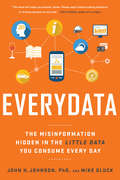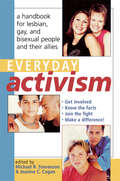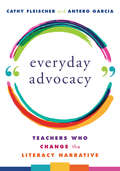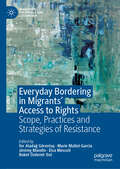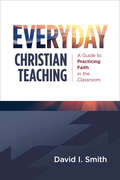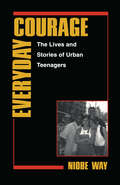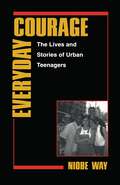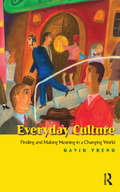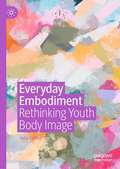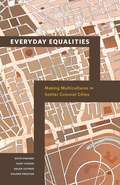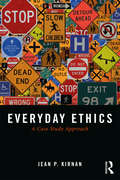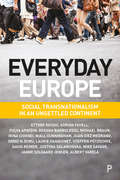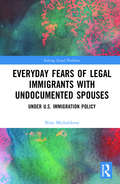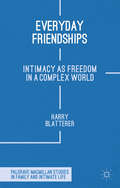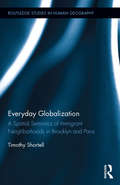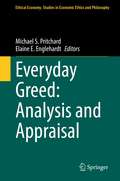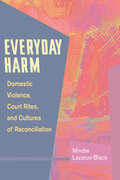- Table View
- List View
Every Household Its Own Government: Improvised Infrastructure, Entrepreneurial Citizens, and the State in Nigeria
by Daniel Jordan SmithAn up-close account of how Nigerians’ self-reliance in the absence of reliable government services enables official dysfunction to strengthen state powerWhen Nigerians say that every household is its own local government, what they mean is that the politicians and state institutions of Africa’s richest, most populous country cannot be trusted to ensure even the most basic infrastructure needs of their people. Daniel Jordan Smith traces how innovative entrepreneurs and ordinary citizens in Nigeria have forged their own systems in response to these deficiencies, devising creative solutions in the daily struggle to survive.Drawing on his three decades of experience in Nigeria, Smith examines the many ways Nigerians across multiple social strata develop technologies, businesses, social networks, political strategies, cultural repertoires, and everyday routines to cope with the constant failure of government infrastructure. He describes how Nigerians provide for basic needs like water, electricity, transportation, security, communication, and education—and how their inventiveness comes with consequences. On the surface, it may appear that their self-reliance and sheer hustle render the state irrelevant. In reality, the state is not so much absent as complicit. Smith shows how private efforts to address infrastructural shortcomings require regular engagement with government officials, shaping the experience of citizenship and strengthening state power.Every Household Its Own Government reveals how these dealings have contributed to forms and practices of governance that thrive on official dysfunction and perpetuate the very inequalities and injustices that afflict struggling Nigerians.
Every Week a Season: A Journey Inside Big-time College Football
by Brian Curtis"Brian Curtis tells the stories behind the stories. He brings the meetings, practice sessions, recruiting calls and game day experience to light like never before. Fans who want to know what goes on behind the scenes will find out in this book. "-RON ZOOK, head football coach, the University of Florida In" Every Week a Season, acclaimed sports reporter and author Brian Curtis takes readers on an unprecedented whirlwind tour of NCAA Division I football. It's a world that breeds great drama, a world that millions watch but few understand. It is a multibillion-dollar business. It is an obsession. To get to the beating heart of college football, Curtis embarked on a breakneck itinerary that took him where all red-blooded college football fans long to be: behind the scenes at nine big-time programs. In nine weeks, Curtis visited Colorado State University, the University of Georgia, Boston College, the University of Tennessee, the University of Maryland, the University of Wisconsin, Louisiana State University, Florida State University, and Arizona State University. He braved the rain to watch Wisconsin pull off the upset of the year; he was at Neyland Stadium to see Tennessee manage a thrilling overtime victory; he was in Tallahassee to witness Florida State's dramatic double overtime battle for the ACC title. As added bonuses, he was with Georgia when the team fought for the SEC Championship, and on the LSU sideline when the boys from Baton Rouge defeated Oklahoma to capture the BCS National Championship. At each stop, he brings us inside the game's inner sanctum: in team meetings and scouting sessions; on the field and on the sidelines, during scrimmages, practices, and games; at pre-game traditions, meals, and religious services; in the locker room before the game and at half-time. Virtually nothing and no one was off-limits. Along with the players, Curtis got to know the coaches-from the youn
Every Woman Is a World
by Gayle WalkerBorn in the remote mountains and tropical forests of southern Mexico, the elder women of Chiapas have witnessed tumultuous change during their lifetimes, which in some cases spanned the entire twentieth century. Through hard experience, these women have gained unique perspectives on the transformations that modernity has brought to their traditional way of life. Reflecting on this rich store of wisdom, artists Gayle Walker and Kiki Suárez began interviewing and photographing Chiapanec women between the ages of 60 and 108. In this book, they present the life stories of twenty-eight women, who speak for the silent members of a divided society - well-to-do, urban ladinas of European descent; mixed race, low-income mestizas; and indigenous Maya from the highlands and Lacandon rainforest. As the women tell their stories, they shed light on major historical events as well as the personal dramas of daily life. For some, the Mexican Revolution and the 1918 Spanish influenza epidemic are still painfully vivid. Others focus on recent social upheavals, such as the 1994 Zapatista Uprising. Women whose families had more resources fondly recall their high school days, while poorer women tell tragic stories of deprivation, hunger, and family violence. Particularly thought-provoking are the women's attitudes toward marriage, work, religion, and their own mortality. Considering the limited opportunities these women faced, Walker and Suárez sum up the significant theme of these interviews by observing that the women of Chiapas "remind us that if we are flexible, creative, and courageous, we have many more possibilities than we think we have. "
Everybody Matters: The Extraordinary Power of Caring for Your People Like Family--Expanded 10th Anniversary Edition
by Bob Chapman Raj SisodiaNow revised and expanded with five new chapters for the 10th anniversary of its 2015 publication, the beloved classic on truly human leadership&“Bob Chapman, CEO of the $1.7 billion manufacturing company Barry-Wehmiller, is on a mission to change the way businesses treat their employees.&” – Inc. MagazineStarting in 1997, Bob Chapman and Barry-Wehmiller have pioneered a dramatically different approach to leadership that creates off-the-charts morale, loyalty, creativity, and business performance. The company utterly rejects the idea that employees are simply functions to be moved around, &“managed&” with carrots and sticks, or discarded at will. Instead, Barry-Wehmiller manifests the reality that every single person matters, just like in a family. It&’s not a cliché on a mission statement; it&’s the bedrock of the company&’s success.It&’s natural to be skeptical when you first hear about this approach. Every time Barry-Wehmiller acquires a company whose team members have experienced more traditional management practices, the new team members are skeptical too. But they soon learn what it&’s like to work at an exceptional company where the goal is for everyone to feel trusted and cared for—and where it&’s expected that they will justify that trust by caring for one another and putting the common good first. Chapman and coauthor Raj Sisodia show how any organization can reject the traumatic consequences of rolling layoffs, dehumanizing rules, and hypercompetitive cultures. In this tenth anniversary update to Everybody Matters, Chapman and Sisodia share new statistics and analysis on the leadership crisis that continues to plague modern businesses and that only Truly Human Leadership—pioneered at Barry-Wehmiller—can fix. Packed with additional insights gained over a decade as the company has evolved, weathered a pandemic, and grown from $1.7 billion in annual revenue with 100 acquisitions to $3.6 billion with more than 140 acquisitions, this updated classic is needed now more than ever.As Chapman says, &“The way we lead impacts the way people live.&” Once you stop treating people like functions or costs, disengaged workers begin to share their gifts and talents in service of a shared future. Uninspired workers stop feeling that their jobs have no meaning. Frustrated workers stop taking their bad days out on their spouses and kids. And everyone stops counting the minutes until it&’s time to go home. This is the journey documented in Everybody Matters; now it&’s time to transform your own workplace.
Everybody Present
by Nikolaj Flor Rotne Didde Flor RotneEverybody Present seeks to create a new kind of culture in our schools: one that counters stress and facilitates learning. It reframes the student-teacher relationship, showing teachers how to supplant antagonism and foster strong relationships by planting seeds of mindfulness in their students and encouraging them to embark on a mindfulness practice of their own.Illustrating the transformative effects of mindfulness on educators, students, and their classrooms, Everybody Present shows how mindfulness helps to strengthen inner peace and prevent stress, foster contagious joy and an ethic of altruism, improve understanding between student and teacher, and fortify competence in educational relations.A working manual addressed to everyone in the educational universe, Everybody Present presents real-world applications grounded in solid research. Stories, exercises, and case studies demonstrate the effectiveness of mindful practices across all areas of education.Everybody Present is intended to contribute to the creation of a culture throughout the educational system writ large, working against stress and victim mentality to set in motion a revolution of silence, allowing each individual the experience of inter-being, inner calm, and joy. By exploring the challenges of teaching, Everybody Present will help all educators transform feelings of inadequacy into experiences of abundance.
Everybody Wants to Rule the World: Surviving and Thriving in a World of Digital Giants
by R Ray" WangWhich kinds of companies will thrive and which will get crushed by the powerful forces in the global business landscape now at work? This groundbreaking new guide will help you adapt and change your business to thrive among digital giants, including Google, Facebook, and Amazon.Drawing on considerable original research and case studies from Wang&’s acclaimed firm, Constellation Research, this groundbreaking guide reveals which kinds of companies will thrive and which will get crushed by the powerful forces now at work.Ultimately, you will understand how the business world is changing in the face of extreme competition and, most importantly, you will learn how to adapt now to stay relevant and in demand.Everybody Wants to Rule the World will help you:Understand the power of Data-Driven Digital Networks and how they have driven the most successful companies of our time.Learn how extreme consolidation is changing the global business landscape and what this means for businesses of all types and sizes in terms of understanding where you fit in the value chain.Gain insights into what innovative companies are doing right now to position themselves in this new reality.Take your business from status quo to market leader.
Everybody Wins: The Chapman Guide to Solving Conflicts Without Arguing
by Gary ChapmanEvery couple has disagreements. All too often, though, when we engage in arguments, our goal is not to resolve the conflict at hand, but rather, to win the fight. Unfortunately, when you win an argument, your spouse is the loser, and nobody wants to be or live with a loser. When you resolve a conflict, your spouse becomes your friend. Good marriages are based on friendship, not on winning arguments. Now, Gary Chapman provides couples with a simple blueprint for achieving win-win solutions to everyday conflicts and disagreements. By learning how to listen empathetically, respecting each other's ideas and feelings, and understanding why particular issues are so important to their spouse, couples can find solutions that result not only in resolving the conflict at hand, but also leave both partners feeling loved, listened to, and appreciated.
Everydata: The Misinformation Hidden in the Little Data You Consume Every Day
by John H. Johnson Mike GluckWhile everyone is talking about "big data," the truth is that understanding the "little data" (stock reports, newspaper headlines, weather forecasts, etc.) is what will help you make smarter decisions at work, at home, and in every aspect of your life. The average person consumes approximately 30 gigabytes of data every single day, but has no idea how to interpret it correctly. Everydata explains, through the eyes of an expert economist and statistician, how to correctly interpret all of the small bytes of data we consume in a day. Readers will become effective, skeptical consumers of everyday data. * Everydata is filled with countless examples of people misinterpreting data - oftentimes with catastrophic results: * Millions of women avoid caffeine during pregnancy because they interpret correlation as causation * The initial launch of HealthCare.gov failed in part because key decision-makers couldn't observe all of the data * A baby food company was investigated by the Federal Trade Commission for cherry picking data * Attorneys faced a $1 billion jury verdict because of outlier data * The Space Shuttle Challenger exploded because the engineers were dealing with a limited sample set * Hedge fund companies claim they can make smarter predictions - but the market data says otherwise Each chapter of Everydata highlights one commonly misunderstood data concept, using both real-world and hypothetical examples from a wide range of topics, including business, politics, advertising, law, engineering, retail, parenting, and more. Readers will get the answer to the question--"Now what?"--along with concrete ways they can use this information to immediately start making smarter decisions, today and every day.
Everyday Activism: A Handbook for Lesbian, Gay, and Bisexual People and their Allies
by Michael R. Stevenson Jeanine C. CoganFrom same-sex marriages to hate-crime laws, gay, lesbian and bisexual people have fought an uphill battle to gain equal rights. Now a comprehensive new reference collects in one volume the strategies, hard data, and legal arguments that are central to the fight for equality in lesbian, gay and bisexual (LGB) life.Up-to-date and readable, Everyday Activism is the one essential book that provides the basic facts on the key questions faced by LGB citizens.
Everyday Advocacy: Teachers Who Change The Literacy Narrative
by Cathy Fleischer Antero GarciaWhat counts as professionalism for teachers today? Once, teachers who knew their content area and knew how to teach it were respected as professionals. Now there is an additional type of competency required: in addition to content and pedagogical knowledge, educators need advocacy skills. In this groundbreaking collection, literacy educators describe how they are redefining what it means to be a teaching professional. Teachers share how they are trying to change the conversation surrounding literacy and literacy instruction by explaining to colleagues, administrators, parents, and community members why they teach in particular research-based ways, so often contradicted by mandated curricula and standardized assessments. Teacher educators also share how they are introducing an advocacy approach to preservice and practicing teachers, helping prepare teachers for this new professionalism. Both groups practice what the authors call “everyday advocacy”: the day-to-day actions teachers are taking to change the public narrative surrounding schools, teachers, and learning.
Everyday Bordering in Migrants’ Access to Rights: Scope, Practices and Strategies of Resistance (Migration, Diasporas and Citizenship)
by Marie Mallet-Garcia Itır Aladağ Görentaş Jérémy Mandin Elsa Mescoli Buket Özdemir DalThis book delves into how everyday bordering—rules and practices used by states for migration governance—impacts migrants&’ access to social rights and shapes their post-migration life. It focuses on the interactions between institutional bodies, agents, and migrants of various profiles, highlighting how these dynamics condition migrants&’ experiences and access to rights. This book offers significant insights into the complex relationship between access to social and fundamental rights and bordering practices, examined at various levels and from complementary perspectives. This book will be of special interest to scholars and students of migration studies and welfare studies, as well as practitioners working in the field of migration.
Everyday Christian Teaching: A Guide to Practicing Faith in the Classroom
by David I. SmithDiscover how ordinary moments in the school year can become occasions for making profound connections between faith and pedagogy. In this encouraging and practical book, education expert David I. Smith invites Christian educators on a journey through the school year that will deepen their capacity to make thoughtful connections between their faith and their pedagogy. Mirroring the rhythms of an academic year, the book embraces and explores the mundane moments that all teachers experience every semester. Starting the course. Setting some norms for interaction. Choosing how to frame the material. Assigning tasks. Repeating things. Pausing. Bringing things to a close. The topics are deliberately ordinary because, as Smith demonstrates, the shape of one&’s teaching is mainly built from the unspectacular choices and actions that gradually shape the texture of life in the classroom. If educators want to think well about Christian faith and teaching and act well in the classroom, they need to learn to reflect well on those ordinary steps in the journey. Everyday Christian Teaching builds on Smith&’s previous book On Christian Teaching: Practicing Faith in the Classroom, where he made a persuasive case for connecting faith and pedagogy. The new book aims to put this idea into practice, as Smith explains in the introduction: &“Suppose we want to get better at thinking about faith and teaching together. What then? What does the road look like, and how do we walk it wisely? If we&’d like to be a pilgrim, how do we make progress?&” Taking up such questions with wisdom and empathy, Everyday Christian Teaching helps educators develop faith-informed insights and life-giving practices that can transform their teaching over the course of time.
Everyday Courage: The Lives and Stories of Urban Teenagers (Qualitative Studies in Psychology #10)
by Niobe WayWhat does it mean to be a teenager in an American city at the close of the twentieth century? How do urban surroundings affect the ways in which teens grow up, and what do their stories tell us about human development? In particular, how do the negative images of themselves on television and in the newspaper affect their perspectives about themselves? Psychologists typically have shown little interest in urban youth, preferring instead to generalize about adolescent development from studies of their middle-class, suburban counterparts. In Everyday Courage Niobe Way, a developmental psychologist, looks beyond the stereotypes to reveal how the personal worldviews of inner-city poor and working-class adolescents develop over time. In the process, she challenges much conventional wisdom about inner-city youth and about adolescents more generally. She introduces us to Malcolm, a sensitive and proud young man full of contradictions. We follow him as he makes the honor roll, becomes a teenage father, and falls into depression as his younger sister is dying of cancer. We meet Eva, an intelligent and confident young women full of questions, who grows increasingly alienated from her mother and comes to rely on her best friends for support. We watch her blossom as a ball player and a poet. We share her triumph when she receives a scholarship to the college of her choice. In these 24 adolescents, Way finds a cross-section of youngsters who want to make positive changes in their lives and communities while struggling with concerns about betrayal, trust, racism, violence, and death. Each adolescent wants most of all to "be somebody," to have her or his voice heard.
Everyday Courage: The Lives and Stories of Urban Teenagers (Qualitative Studies in Psychology #10)
by Niobe WayA developmental analysis of adolescents growing up in an inner-city, working class lifeWhat does it mean to be a teenager in an American city at the close of the twentieth century? How do urban surroundings affect the ways in which teens grow up, and what do their stories tell us about human development? In particular, how do the negative images of themselves on television and in the newspaper affect their perspectives about themselves? Psychologists typically have shown little interest in urban youth, preferring instead to generalize about adolescent development from studies of their middle-class, suburban counterparts. In Everyday Courage Niobe Way, a developmental psychologist, looks beyond the stereotypes to reveal how the personal worldviews of inner-city poor and working-class adolescents develop over time. In the process, she challenges much conventional wisdom about inner-city youth and about adolescents more generally. She introduces us to Malcolm, a sensitive and proud young man full of contradictions. We follow him as he makes the honor roll, becomes a teenage father, and falls into depression as his younger sister is dying of cancer. We meet Eva, an intelligent and confident young women full of questions, who grows increasingly alienated from her mother and comes to rely on her best friends for support. We watch her blossom as a ball player and a poet. We share her triumph when she receives a scholarship to the college of her choice. In these 24 adolescents, Way finds a cross-section of youngsters who want to make positive changes in their lives and communities while struggling with concerns about betrayal, trust, racism, violence, and death. Each adolescent wants most of all to "be somebody," to have her or his voice heard.
Everyday Culture: Finding and Making Meaning in a Changing World
by David TrendEveryday Culture examines the confluence of cultural and material possibility--the bringing together of thought and action in daily life. David Trend argues that an informed and invigorated citizenry can help reverse patterns of dehumanization and social control. The impetus for Everyday Culture can be described in the observation by Raymond Williams that the "culture is ordinary," and that the fabric of meanings that inform and organize everyday life often go undervalued and unexamined. Everyday Culture shares with thinkers like Williams the conviction that it is precisely the ordinariness of culture that makes it extraordinarily important. The ubiquity of everyday culture means that it affects all aspects of contemporary economic, social, and political life.
Everyday Eating: Food, Taste and Trends in Britain since the 1950s
by Alan WardeHow have eating habits changed in recent decades? What does it mean to eat well? This fascinating book examines continuity and change in food consumption and eating patterns since the 1950s. The culinary landscape of Britain is explored through discussion of commodification, globalisation and diversification enabling an understanding of both developing trends and enduring habits. The author’s research undertaken over 40 years offers fresh insights into such practices as everyday meals, shopping, cooking and dining out and how these are shaped by demographic, social and cultural processes. The book provides a comprehensive and engaging analysis of eating in Britain today and of the many controversies about how this has changed.
Everyday Embodiment: Rethinking Youth Body Image
by Julia CoffeyThis book offers an innovative conceptual and methodological approach to one of the most significant health and wellbeing challenges for contemporary youth: body image. The social and cultural dimensions shaping body ideals and young people’s body image concerns have not been adequately explored in the current landscape of social media and youth body cultures. The author provides a sociological reframing of body image, foregrounding the social and cultural dimensions which are critical in shaping young people’s everyday bodily experiences. Chapters explore the significance of ‘gender’ and ‘wellbeing’ norms and the ways that circumstances of hardship and inequality are significant in mediating body concerns. In this, the book complicates simplistic understandings of body image, instead showing the complex processes by which body concerns are formed through the circumstances of embodied experience. The book advocates for the non-individual dimensions of body concerns—the social and cultural conditions of young people’s lives—to be foregrounded in strategies aimed at addressing this complex youth wellbeing issue. This text will be of interest to scholars in gender studies, youth studies, and feminist sociology.
Everyday Equalities: Making Multicultures in Settler Colonial Cities
by Valerie Preston Kurt Iveson Ruth Fincher Helga LeitnerA timely new look at coexisting without assimilating in multicultural cities If city life is a &“being together of strangers,&” what forms of being together should we strive for in cities with ethnic and racial diversity? Everyday Equalities seeks evidence of progressive political alternatives to racialized inequality that are emerging from everyday encounters in Los Angeles, Melbourne, Sydney, and Toronto—settler colonial cities that, established through efforts to dispossess and eliminate indigenous societies, have been destinations for waves of immigrants from across the globe ever since. Everyday Equalities finds such alternatives being developed as people encounter one another in the process of making a home, earning a living, moving around the city, and forming collective actions or communities. Here four leading scholars in critical urban geography come together to deliver a powerful and cohesive message about the meaning of equality in contemporary cities. Drawing on both theoretical reflection and urban ethnographic research, they offer the formulation &“being together in difference as equals&” as a normative frame to reimagine the meaning and pursuit of equality in today&’s urban multicultures. As the examples in Everyday Equalities indicate, much emotional labor, combined with a willingness to learn from each other, negotiate across differences, and agitate for change goes into constructing environments that foster being together in difference as equals. Importantly, the authors argue, a commitment to equality is not only a hope for a future city but also a way of being together in the present.
Everyday Ethics: A Case Study Analysis
by Jean P. KirnanThis book expands the current discussion on ethics, addressing the gap between "headline" ethics cases, which are often extreme and taken from a business context, and the everyday ethical challenges that we all face in school, work, relationships, and communities. Case studies throughout demonstrate concepts and provide opportunities for readers to apply theory as they consider everyday issues such as the temptation to lie about an arrest on a job application, peer pressure to steal or drink, and the implications of "ratting out" a classmate who is cheating or a co-worker who is stealing. By including a broad array of ethical challenges, this book makes ethics more accessible to the reader. Drawing from several academic disciplines, including social psychology and organizational behavior, this book explores the personal and environmental factors that influence our ethical decision-making. The book is appropriate for ethics courses in an array of disciplines as well as anyone interested in ethical challenges.
Everyday Europe: Social Transnationalism in an Unsettled Continent
by Adrian Favell Ettore RecchiDrawing on unique research and rich data on cross-border practices, this book offers an empirically-based view on Europeans’ interconnections in everyday life. It looks at the ways in which EU residents have been getting closer across national frontiers: in their everyday experiences of foreign countries – work, travel, personal networks – but also their knowledge, consumption of foreign products, and attitudes towards foreign culture. These evolving European dimensions have been enabled by the EU-backed legal opening to transnational economic and cultural transactions, while also differing according to national contexts. The book considers how people reconcile their increasing cross-border interconnections and a politically separating Europe of nation states and national interests.
Everyday Fears of Legal Immigrants with Undocumented Spouses: Under U.S. Immigration Policy (Solving Social Problems)
by Nina MichalikovaThis book examines the adaptation experiences of legal immigrants with undocumented spouses, considering the structural limitations that they face in their private, social, and professional lives, as well as in regard to their finances and health. The first study to systematically analyze the ways in which legal immigrants are affected by federal and state policies that target their undocumented spouses, it reveals that, regardless of their immigration status, all members of mixed-status families are directly or indirectly subjected to the same intrusive and punitive laws. Based on an autoethnographic approach, Everyday Fears of Legal Immigrants with Undocumented Spouses: Under U.S. Immigration Policy also draws on additional qualitative research as well empirical evidence from existing studies and the latest quantitative data from various governmental agencies and think tanks. It thus integrates multiple approaches to ways of knowing and understanding the experiences of legal immigrants in mixed-status families and will therefore appeal to social scientists with interests in migration.
Everyday Friendships: Intimacy as Freedom in a Complex World (Palgrave Macmillan Studies in Family and Intimate Life)
by H. BlattererThis book conceptualises the lived experience of intimacy in a world in which the terms and conditions of love and friendship are increasingly unclear. It shows that the analysis of the 'small world' of dyads can give important clues about society and its gendered makeup.
Everyday Globalization: A Spatial Semiotics of Immigrant Neighborhoods in Brooklyn and Paris (Routledge Studies in Human Geography #60)
by Timothy ShortellEveryday Globalization is a micro-sociological study of immigrant neighborhoods in Brooklyn and Paris. Global flows of people bring together cultural practices from distant places and urban dwellers in global cities interpret the signs of collective identity in ascribing particular places as "immigrant neighborhoods." This book examines the spatial semiotics of identity in urban public space that make this possible. Unlike other studies of globalization and cities, this work brings together research on the social psychology of groups, linguistic landscapes, and quotidian mobility to explain how urban dwellers encounter cultural differences. Signs of social identity are always interpreted in the context of group boundaries and the appropriation of public space. The breadth of this analysis contributes to the literature in human geography on the meaningfulness of places. This book will also be of interest to scholars and students in visual sociology. In addition, this research demonstrates an innovative method for studying everyday urban experience.
Everyday Greed: Analysis and Appraisal (Ethical Economy #58)
by Michael S. Pritchard Elaine E. EnglehardtThis collection examines how greed should be understood and appraised. Roundly condemned by virtually all religions, greed receives mixed appraisals in the domains of business and economics. The volume examines these mixed appraisals and how they fare in light of their implications for greed in our everyday world. Greed in children is uniformly criticized by parents, other adults, and even children’s peers. However, in adulthood, greed is commended by some as essential to profit-seeking in business and for offering the greatest promise in promoting economic prosperity for everyone.Those who advocate a more permissive position on greed in the adult world typically concede that some constraints on greed are needed. However, the supporting literature offers little analysis of what greed is (as distinct from, for example, the effort to meet modest needs, or the pursuit of ordinary self-interested ends). It offers little clarification of what sorts of constraints on greed are needed. Nor is careful attention given to difficulties children might have in making a transition without moral loss from regarding greed as inappropriate to its later qualified acceptance. Through a secular approach, this book attempts to make significant inroads in remedying these shortcomings.
Everyday Harm: Domestic Violence, Court Rites, and Cultures of Reconciliation
by Mindie Lazarus-BlackExposing the powerful contradictions between empowering rights and legal rites By investigating the harms routinely experienced by the victims and survivors of domestic violence, both inside and outside of law, Everyday Harm studies the limits of what domestic violence law can--and cannot--accomplish. Combining detailed ethnographic research and theoretical analysis, Mindie Lazarus-Black illustrates the ways persistent cultural norms and ingrained bureaucratic procedures work to unravel laws designed to protect the safety of society’s most vulnerable people. Lazarus-Black’s fieldwork in Trinidad traces a story with global implications about why and when people gain the right to ask the court for protection from violence, and what happens when they pursue those rights in court. Why is itthat, in spite of laws designed to empower subordinated people, so little results from that legislation? What happens in and around courts that makes it so difficult for people to obtain their legally available rights and protections? In the case of domestic violence law, what can such legislation mean for women’s empowerment, gender equity, and protection? How do cultural norms and practices intercept the law?
